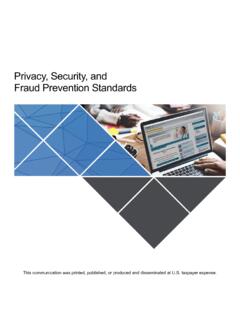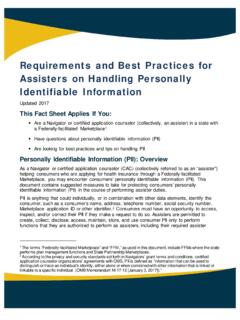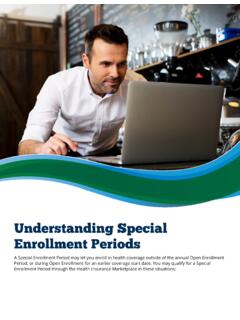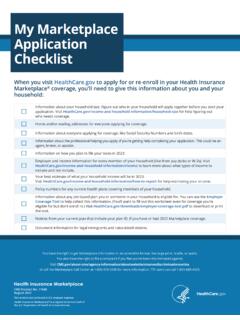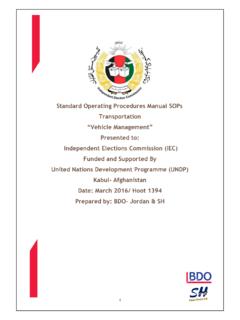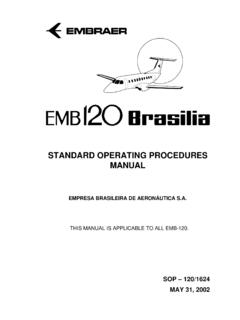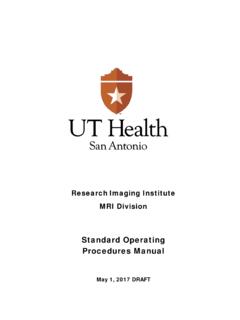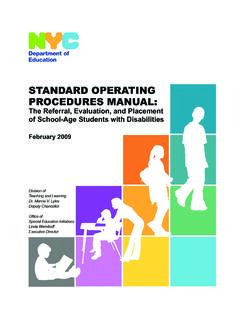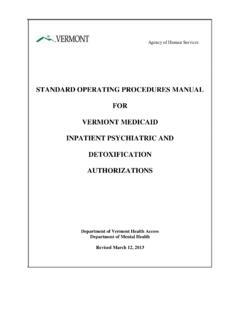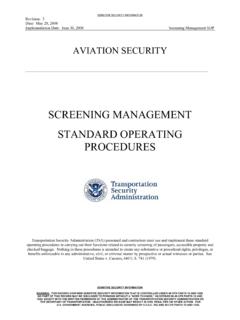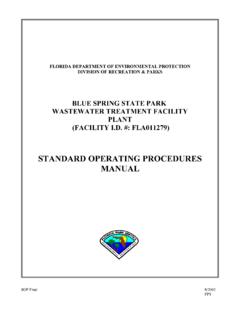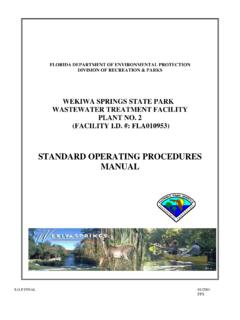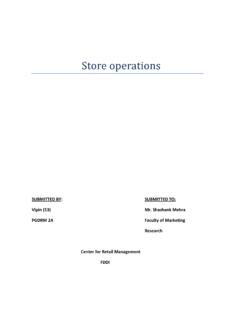Transcription of Assister Standard Operating Procedures - …
1 Assister Standard Operating Procedures This communication was printed, published, or produced and disseminated at taxpayer expense. Table of Contents Course Introduction .. 5 Welcome .. 5 Disclaimer .. 8 Welcome .. 9 Course Goal .. 10 Resources .. 11 Overview of Resources .. 12 Standard Operating Procedures manual for Assisters in the Individual FFMs .. 13 The Assister s Roadmap to Resources .. 15 Assister Newsletters, Webinars, and Communications .. 16 IRS Consumer Tax Forms and Resources .. 18 Frequently Used Resources .. 20 Frequently Used Resources (cont'd) .. 21 Frequently Used Resources (cont'd) .. 22 Knowledge Check .. 23 Key Points .. 24 Helping Consumers Understand Marketplace Coverage Tax Forms.
2 25 Introduction .. 25 Introduction to Tax Forms for the Premium Tax Credit .. 26 Accessing and Understanding the General Purpose of IRS Form 1095-A .. 27 The Second Lowest Cost Silver Plan .. 28 Additional IRS Forms .. 30 Availability of IRS Resources, Including the General Purpose of and How to Access IRS Form 8962 .. 31 Applying for Advance Payments of the Premium Tax Credit Scenario .. 32 Key Points .. 34 Engaging Consumers in the Marketplaces .. 35 Introduction .. 35 Outreach or Enrollment Events .. 36 Preparing Consumers to Enroll in Coverage .. 38 Questions to Consider When Helping Consumers .. 40 Responding to Enrollment Objections From Eligible Consumers .. 42 Responding to Enrollment Objections From Eligible Consumers (cont'd).
3 43 Additional Objections From Eligible Consumers .. 44 Knowledge Gaps .. 45 Helping Consumers Find Coverage That Best Fits Their Needs .. 46 Using the 3 Cs to Help New Consumers .. 47 Plan Selection: Reviewing Coverage Options .. 49 Identifying Plan Coverage Needs .. 51 Post Enrollment Follow-up .. 53 Additional Tips on Customer Service .. 54 Additional Tips on Customer Service (cont'd) .. 55 Key Points .. 56 Where to Seek Help for Common Issues .. 57 Introduction .. 57 Contacts for Additional Consumer Support .. 58 FFM Call Center .. 59 FFM Call Center (cont'd) .. 61 Marketplace Issuers .. 62 Eligibility Appeals .. 64 CMS Health Insurance Casework System .. 66 CMS Health Insurance Casework System (cont'd).
4 68 Knowledge Check .. 69 Key Points .. 70 Assister Community Collaboration and Consumer Referrals to Outside Organizations . 71 Introduction .. 71 What Kind of Referrals are Required? .. 73 Consumers with Grievances, Complaints, and Questions about Health Coverage .. 74 Consumer Questions about Certain Tax Topics .. 75 Consumers Legal Questions about FFM Eligibility Appeals .. 77 Navigator Referrals to Other Assisters, the FFM Call Center, or Other Resources .. 78 CAC Referrals to Other Assisters, the FFM Call Center, or Other Resources .. 79 Non-required Referrals and Other Ways Assisters Can Work with Outside Organizations .. 80 Consumer Referrals to Agents and Brokers .. 82 Do s and Don ts for Working with Outside Organizations: the Do s.
5 83 Do s and Don ts for Working with Outside Organizations: the Do s .. 85 Do s and Don ts for Working with Outside Organizations: The Don ts .. 87 Tips for Identifying Organizations for Partnership or Collaboration .. 88 Knowledge Check .. 90 Key Points .. 91 Conclusion .. 92 Resources .. 93 Course Introduction Welcome You need to be aware of these training disclaimers. Assister Training Content The information provided in this training course is not intended to take the place of the statutes, regulations, and formal policy guidance that it is based upon. This course summarizes current policy and operations as of the date it was uploaded to the Marketplace Learning Management System. Links to certain source documents have been provided for your reference.
6 We encourage persons taking the course to refer to the applicable statutes, regulations, CMS Assister webinars, and other interpretive materials for complete and current information. In this course, there are some references and links to nongovernmental third-party websites. CMS offers these links for informational purposes only, and inclusion of these websites should not be construed as an endorsement of any third-party organization's programs or activities. Individual Shared Responsibility Payment and Exemptions In this course, there are numerous references to the individual shared responsibility provision and exemptions from it. Under the Tax Cuts and Jobs Act of 2017, taxpayers must continue to report minimum essential coverage, qualify for an exemption, or pay an individual shared responsibility payment for tax years prior to 2019.
7 For tax year 2018 only (for which consumers generally filed taxes by April 2019), consumers do not have to fill out an application to get a hardship exemption certificate number (ECN). Consumers can claim the exemption without having to submit documentation about the hardship on their 2018 federal tax returns. Beginning with tax year 2019, individuals who choose to go without insurance will no longer be subject to making individual shared responsibility payments. However, as set forth in (h), individuals age 30 and above must continue to obtain and report an affordability or hardship exemption ECN if they wish to purchase Catastrophic health coverage. Navigator Physical Presence Requirement Effective June 18, 2018, Navigators in FFMs are no longer required to maintain a physical presence in their Marketplace service area.
8 In some cases, Navigators may provide remote application assistance ( , online or by phone), provided that such assistance is permissible under their organization's contract, grant terms and conditions, or agreement with CMS and/or their organization. For additional guidance on obtaining consumers' consent remotely over the phone, visit: FFM Navigator Duties Beginning with Navigator grants awarded in 2019, FFM Navigators may but are no longer required to assist consumers with the following services: 1. Understanding the process of filing Marketplace eligibility appeals; 2. Understanding and applying for exemptions from the individual shared responsibility provision granted through the Marketplace and/or claimed through the tax filing process; 3.
9 Marketplace-related components of the premium tax credit reconciliation process; 4. Understanding basic concepts and rights related to health coverage and how to use it; and 5. Referrals to licensed tax advisers, tax preparers, or other resources for assistance with tax preparation and tax advice related to consumer questions about the Marketplace application and enrollment process, exemptions from the requirement to maintain minimum essential coverage and from the individual shared responsibility payment, and premium tax credit reconciliations. CMS will continue to provide all assisters with additional information related to these assistance activities through webinars, job aids, and other technical assistance resources.
10 SHOP Assistance Federally-facilitated SHOP Marketplaces (FF-SHOPs) and State-based Marketplaces (SBMs) using the federal SHOP platform will no longer offer employee eligibility, premium aggregation, or online enrollment functionality. Instead, qualified employers can purchase and enroll employees in SHOP plans by working with a qualified health plan (QHP) issuer or SHOP-registered agent or broker. However, small employers in states with a FF-SHOP or SBM using the federal SHOP platform can continue to use the SHOP website to: 1. Learn about the benefits of SHOP, including tax credits for qualified employers; 2. Compare available medical and dental plans side by side using the SHOP See Plans and Prices tool; and 3.
